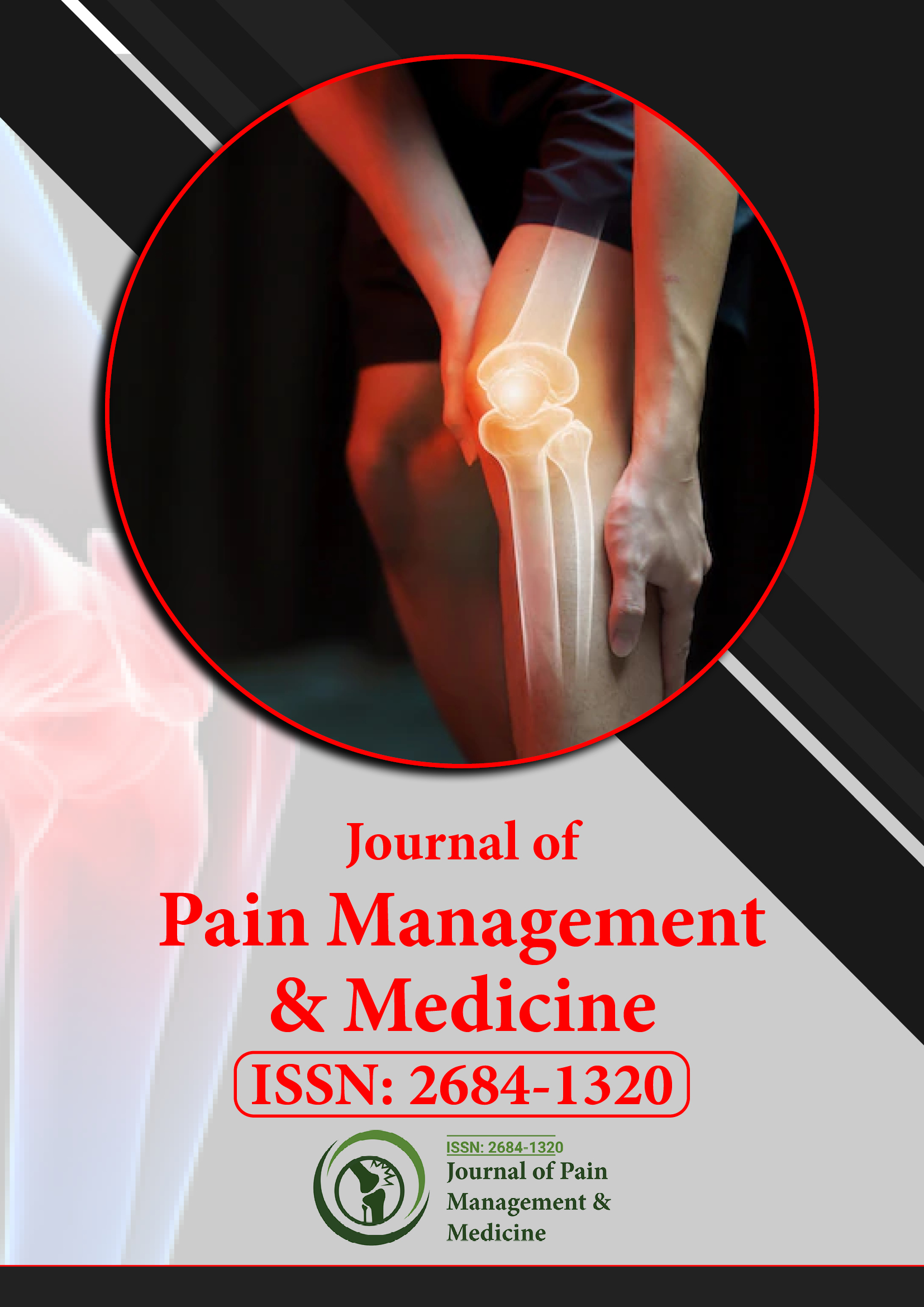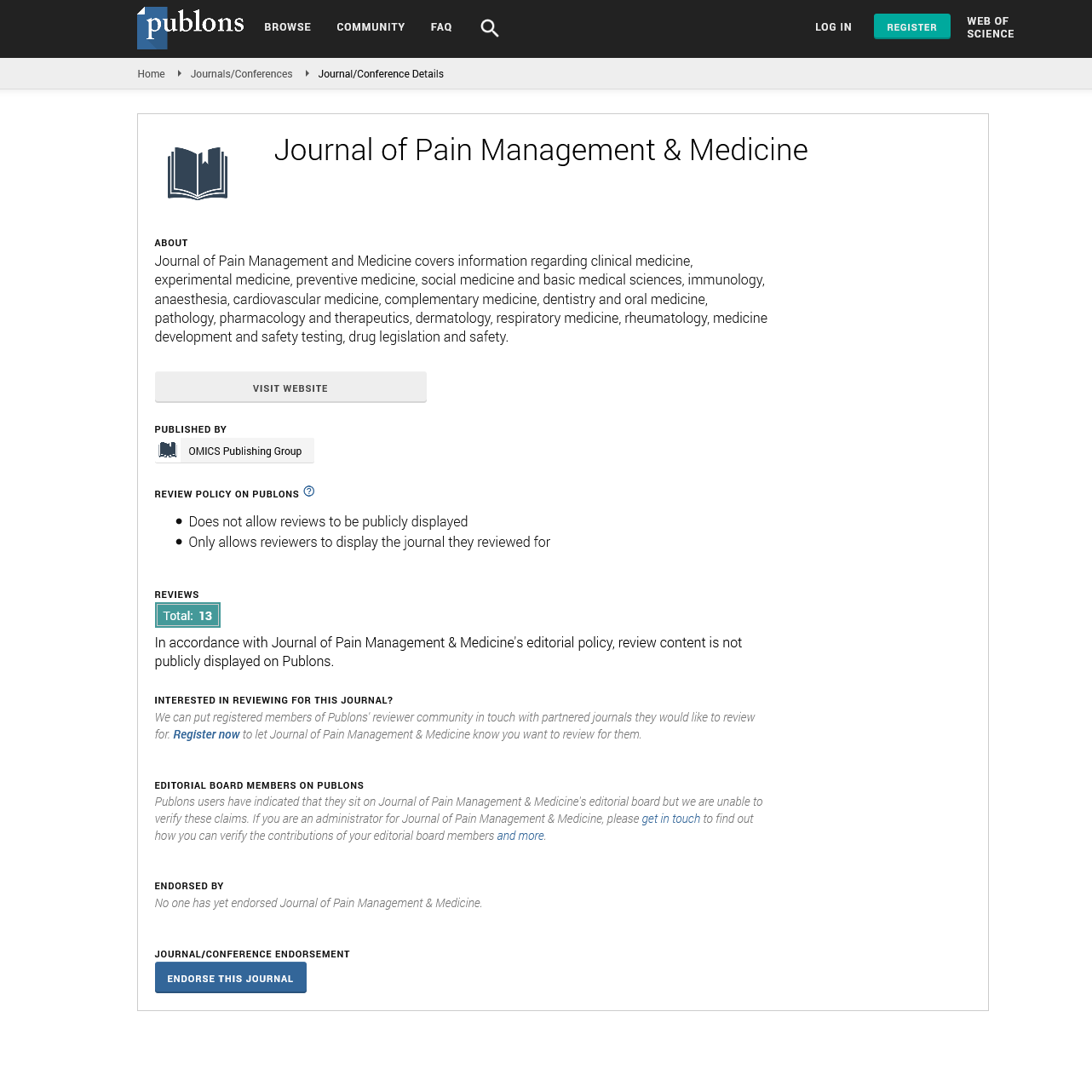Indexed In
- RefSeek
- Hamdard University
- EBSCO A-Z
- Publons
- Euro Pub
- Google Scholar
- Quality Open Access Market
Useful Links
Share This Page
Journal Flyer

Open Access Journals
- Agri and Aquaculture
- Biochemistry
- Bioinformatics & Systems Biology
- Business & Management
- Chemistry
- Clinical Sciences
- Engineering
- Food & Nutrition
- General Science
- Genetics & Molecular Biology
- Immunology & Microbiology
- Medical Sciences
- Neuroscience & Psychology
- Nursing & Health Care
- Pharmaceutical Sciences
Commentary - (2025) Volume 11, Issue 1
Effectiveness of Interdisciplinary Pain Rehabilitation Programs for Improving Quality of Life in Patients with Complex Regional Pain Syndrome
Ethan T. Chen*Received: 01-Mar-2025, Manuscript No. JPMME-25-28847 ; Editor assigned: 03-Mar-2025, Pre QC No. JPMME-25-28847 (PQ); Reviewed: 17-Mar-2025, QC No. JPMME-25-28847 ; Revised: 24-Mar-2025, Manuscript No. JPMME-25-28847 (R); Published: 31-Mar-2025, DOI: 10.35248/2684-1320.25.11.312
Description
Complex Regional Pain Syndrome (CRPS) is a debilitating neuroinflammatory condition characterized by chronic, often severe pain, sensory abnormalities, motor dysfunction, autonomic disturbances, and psychological distress. Due to its multifaceted nature, a single-modality treatment approach is often insufficient. Interdisciplinary Pain Rehabilitation Programs (IPRPs), which integrate medical, physical, psychological, and occupational therapies, are increasingly recognized as a cornerstone in the comprehensive management of CRPS. Evaluating the effectiveness of IPRPs in improving the Quality Of Life (QoL) of individuals with CRPS is crucial for establishing best practices and advocating for wider access to these intensive interventions.
One of the most significant aspects to consider is the holistic approach of IPRPs in addressing the complex interplay of physical, psychological, and social factors that contribute to the diminished QoL in CRPS patients. Unlike unimodal treatments that focus solely on pain reduction, IPRPs aim to improve functional capacity, reduce disability, manage pain effectively, address psychological comorbidities like anxiety and depression, enhance coping skills, and promote self-management strategies. This comprehensive approach directly targets the multiple domains that contribute to a patient's overall well-being and QoL.
The integration of various therapeutic modalities within IPRPs is another key element to evaluate. Physical therapy often focuses on graded motor imagery, desensitization techniques, and functional exercises to improve movement and reduce pain-related disability. Occupational therapy addresses activities of daily living and vocational rehabilitation. Psychological interventions, such as Cognitive Behavioral Therapy (CBT) and Acceptance and Commitment Therapy (ACT), help patients manage pain-related thoughts, emotions, and behaviors, promoting psychological flexibility and improved coping. Medical management within IPRPs ensures appropriate pharmacological interventions are utilized while often emphasizing a multidisciplinary perspective on medication use and potential weaning from opioids. The synergistic effect of these integrated therapies is hypothesized to lead to more significant and sustained improvements in QoL compared to isolated treatments.
The intensity and duration of IPRPs are important factors to consider when assessing their effectiveness. These programs typically involve several hours of therapy per day, multiple days per week, over a period of weeks or even months. This intensive format allows for consistent reinforcement of therapeutic strategies and the development of strong therapeutic alliances between patients and the multidisciplinary team. Evaluating whether this intensity is a key driver of improved QoL and identifying the optimal duration of programs for different patient subgroups are important areas of research.
Patient-centered goals and active participation are central tenets of effective IPRPs. The focus is often on improving function and participation in meaningful activities rather than solely on achieving complete pain relief, which may not be realistic for many CRPS patients. Evaluating the extent to which IPRPs empower patients to set and achieve their own goals, develop self-efficacy in managing their condition, and actively engage in the rehabilitation process is crucial for understanding their impact on QoL.
The long-term outcomes following IPRP participation are particularly relevant for assessing their true effectiveness in improving QoL. While short-term improvements in pain and function are often reported, the sustainability of these gains and their impact on QoL over months and years need to be rigorously evaluated. Follow-up studies are essential to determine the lasting benefits of IPRPs and to identify factors that predict long-term success.
The role of the multidisciplinary team and the therapeutic relationship between patients and providers within IPRPs are critical aspects to consider. The coordinated effort of physicians, physical therapists, occupational therapists, psychologists, and other specialists, working collaboratively with the patient, can foster a sense of support, understanding, and hope. Evaluating the impact of team cohesion and the quality of the patient-provider relationship on QoL outcomes is important.
Finally, considering the cost-effectiveness of IPRPs is essential for advocating for their wider implementation and insurance coverage. While IPRPs may involve a significant upfront investment, the potential for reduced long-term healthcare costs associated with decreased reliance on pharmacological interventions, fewer hospitalizations, and improved functional capacity and return to work could make them a cost-effective strategy for managing CRPS in the long run. Pharmacoeconomic evaluations are needed to demonstrate this value.
In conclusion, the effectiveness of interdisciplinary pain rehabilitation programs for improving the quality of life in patients with complex regional pain syndrome warrants thorough investigation. By addressing the multifaceted nature of CRPS, integrating various therapies, emphasizing patient-centered goals, and fostering a strong therapeutic alliance, IPRPs hold significant promise for enhancing the well-being and functional capacity of individuals living with this challenging condition. Rigorous research focusing on long-term outcomes, the role of the multidisciplinary team, and cost-effectiveness is crucial for establishing IPRPs as a standard of care for CRPS.
Citation: Chen ET (2025) Effectiveness of Interdisciplinary Pain Rehabilitation Programs for Improving Quality of Life in Patients with Complex Regional Pain Syndrome. J Pain Manage Med. 11.312
Copyright: © 2025 Chen ET. This is an open access article distributed under the terms of the Creative Commons Attribution License, which permits unrestricted use, distribution, and reproduction in any medium, provided the original author and source are credited.

